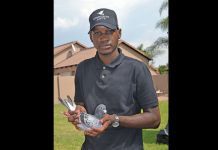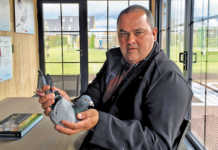
Once upon a time, a pigeon loft would be considered fortunate if it produced a true champion racer once in 10 years. This is no longer good enough given the demands made by pigeon racing today. Due to skilful breeding, the gap between the 1st and 30th position in pigeon racing is narrower than ever before. Winning margins are often milliseconds apart. If your pigeon stops to blink before trapping, it might end up in the 2nd or 3rd position. Between the contrasting worlds of ‘sprint’ and ‘plod’ – the stayers that win a marathon race with an hour or more to spare – are a new generation of super breeders and racers. They’re unstoppable and change the fortunes of struggling fanciers by putting beginners on the map.
Specialist selection
The prime lesson of the performance gene pool is the fact that despite occasional crossing, good genes are passed on. This proves what can be achieved when one uses superior stock and does selective matings. Fewer than a handful
of superior breeders dominate as hereditary transmitters in which multiple winners and a champion racer show up in virtually every generation. Take the Painter Putteries, for example.
This produced Fairthorn, the Sun City Million Dollar Pigeon Race winner against 29 countries in 2001, and few other pigeon families have managed to equal the impact of these birds in South Africa. Rooted within the various pedigrees of super racers and breeders, the Painter Putteries tower above all.
From the outset, Ds Gert Painter set out to combine all the desirable ‘champion characteristics’ into one pigeon family. In his 2005 sales catalogue, he describes how, over 40 years, he selected according to exceptional character traits – silky feather quality, will to win, high performance hit-rate, and so on. The pigeons that failed to meet his standards were culled ruthlessly.
Space prevents us from telling the entire story, but the following highlights of how this super pigeon family was formed should provide enough insight into its extraordinary gene pool. The development of the family can be divided into three phases: the 1960s, 1970s and 1990s. The first pigeons – of Putterie Slimme origin – were acquired in the early 1960s by Gert Painter’s brother, Wilkie, who obtained them at great expense from the late Sonny Kippen.
These birds were direct or second generation descendants of great pigeons such as The Lady Dudley Cock, Grootte, The Queen, Louis, Lorraine, Young Slimme, Shirley, Combine Lady and Lady Superior. Whilst Wilkie dominated with these pigeon in the West Rand for years, Gert dominated pigeon racing in Upington during 1962 and Port Elizabeth’s strong Union in 1966.
Pure Old Putteries from the late Koos Bantjes was introduced in about 1966. These birds further improved on the performances of the mainly Kippen-based strain. Gert moved to Johannesburg in 1970 and began dominating the pigeon scene in three clubs: Pirates, Randburg and the Northern Districts Homing Society.
In the late 1970s, Gert bought two pigeons from the late Les Spark. Both were out of Danie Cilliers’ famous Golden Eye Hen that originated from the old Putteries of Lou Holbert and Chris Neethling. One of these chicks, 2248/77 – later known as the Golden Eye Cock – laid the foundation of the Painter Putterie strain of today.
Warmbad cock
The first crosses between the Painter Putteries and descendants of the famous Warmbad cock (830/78) and its son Sprint (44297/81) from ‘Klein Chris Marais’ lofts were made in 1992. Within three years, more than 40 winners, distributed over four lofts, were bred this way. “It was like throwing a burning match into a tank of petrol,” says Gert. These Marais-based introductions of Delbar/Putterie/Slimme/Ducheyne were the final piece of the foundation for the Painter’s Sun City win in 2001.
Contact Thomas Smit on 011 680 4778 or at [email protected]. Please state ‘Pigeons’ in the subject line of your email.












